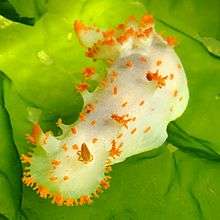Polyceridae
The Polyceridae are a taxonomic family of sea slugs, dorid nudibranchs, marine gastropod mollusks within the superfamily Polyceroidea.[1]
| Polyceridae | |
|---|---|
 | |
| Triopha catalinae in situ, head at lower left | |
| Scientific classification | |
| Kingdom: | Animalia |
| Phylum: | Mollusca |
| Class: | Gastropoda |
| Subclass: | Heterobranchia |
| Order: | Nudibranchia |
| Suborder: | Doridina |
| Superfamily: | Polyceroidea |
| Family: | Polyceridae Alder & Hancock, 1845 |
| Genera | |
|
See text. | |
Taxonomy
The family Polyceridae is classified within the clade Doridacea, itself belonging to the clade Euctenidiacea within the clade Nudipleura (according to the taxonomy of the Gastropoda by Bouchet & Rocroi, 2005).
The Polyceridae consists of these subfamilies:
- Kalinginae Pruvot-Fol, 1956
- Kankelibranchinae Ortea, Espinosa & Caballer, 2005
- Nembrothinae Burn, 1967
- Polycerinae Alder & Hancock, 1845 - synonyms: Triopinae Gray, 1847, Euphuridae Iredale & O'Donoghue, 1923, Gymnodorididae Odhner, 1941
- Triophinae Odhner, 1941
- tribe Triophini Odhner, 1941 - synonym: Kaloplocaminae Pruvot-Fol, 1954
- tribe Limaciini Winckworth, 1951 - synonym: Lailinae Burn, 1967
Genera
Genera in the Polyceridae include:[1]
- Subfamily Kalinginae Pruvot-Fol, 1956
- Genus Kalinga Alder & Hancock, 1864 - type genus in the subfamily Kalinginae
- Subfamily Kankelibranchinae Ortea, Espinosa & Caballer, 2005
- Genus Kankelibranchus Ortea, Espinosa & Caballer, 2005
- Subfamily Nembrothinae Burn, 1967
- Genus Martadoris Willan & Chang, 2017
- Genus Nembrotha Bergh, 1877 - type genus in the subfamily Nembrothinae
- Genus Roboastra Bergh, 1877
- Genus Tambja Burn, 1962
- Genus Tyrannodoris Willan & Chang, 2017
- Subfamily Polycerinae Alder & Hancock, 1845
- Genus Greilada Bergh, 1894
- Genus Gymnodoris Stimpson, 1855
- Genus Lamellana Lin, 1992
- Genus Lecithophorus Macnae, 1958
- Genus Palio Gray, 1857
- Genus Paliolla Burn, 1958
- Genus Polycera Cuvier, 1817 - type genus in the family Polyceridae
- Genus Polycerella A. E. Verrill, 1881
- Genus Thecacera Fleming, 1828
- Subfamily Triophinae Odhner, 1941
- Genus Colga Bergh, 1880
- Genus Crimora Alder and Hancock, 1855
- Genus Heteroplocamus Oliver, 1915
- Genus Holoplocamus Odhner, 1926
- Genus Joubiniopsis Risbec, 1928
- Genus Kaloplocamus Bergh, 1893
- Genus Limacia O.F. Müller, 1781
- Genus Plocamopherus (Rüppell & Leuckart, 1831)
- Genus Triopha Bergh, 1880 - type genus in the subfamily Triophinae
- Genera brought into synonymy
- Genus Cabrilla Fewkes, 1889: synonym of Triopha Bergh, 1880
- Genus Euplocamus Philippi, 1836: synonym of Kaloplocamus Bergh, 1892
- Genus Histiophorus Pease, 1860: synonym of Plocamopherus Rüppell in Rüppell & Leuckart, 1828
- Genus Issa Bergh, 1881: synonym of Colga Bergh, 1880
- Genus Issena Iredale & O'Donoghue, 1923: synonym of Colga Bergh, 1880:
- Genus Laila MacFarland 1905: synonym of Limacia Muller, 1781 [2]
- Genus Peplidia Lowe, 1842: synonym of Plocamopherus Rüppell in Rüppell & Leuckart, 1828
gollark: I thought about that, but:- strings in a binary format will be about the same length- integers will have some space saving, but I don't think it's very significant- it would, in a custom one, be harder to represent complex objects and stuff, which some extensions may be use- you could get some savings by removing strings like "title" which XTMF repeats a lot, but at the cost of it no longer being self-describing, making extensions harder and making debugging more annoying- I am not convinced that metadata size is a significant issue
gollark: I mean, "XTMF with CBOR/msgpack and compression" was being considered as a hypothetical "XTMF2", but I'd definitely want something, well, self-describing.
gollark: Also also, why a binary format?
gollark: Also, XTMF can do runtime update, you just need to allocate, say, 4KB at the start of the tape, and write metadata to that. The offsets might be fiddly, though.
gollark: You should probably not do that.
References
- Polyceridae Alder & Hancock, 1845. Retrieved through: World Register of Marine Species on 10 January 2019.
- Vallès, Y.; Valdés, A.; Ortea, J. 2000. On the phanerobranch dorids of Angola (Mollusca, Nudibranchia): A crossroads of temperate and tropical species. Zoosystema, 22(1): 15-31.
- http://www.seaslugforum.net accessed 16 September 2009
- Gosliner, T.M. 1987. Nudibranchs of Southern Africa ISBN 0-930118-13-8
- Vaught, K.C. (1989). A classification of the living Mollusca. American Malacologists: Melbourne, FL (USA). ISBN 0-915826-22-4. XII, 195 pp.
| Wikispecies has information related to Polyceridae |
| Wikimedia Commons has media related to Polyceridae. |
This article is issued from Wikipedia. The text is licensed under Creative Commons - Attribution - Sharealike. Additional terms may apply for the media files.